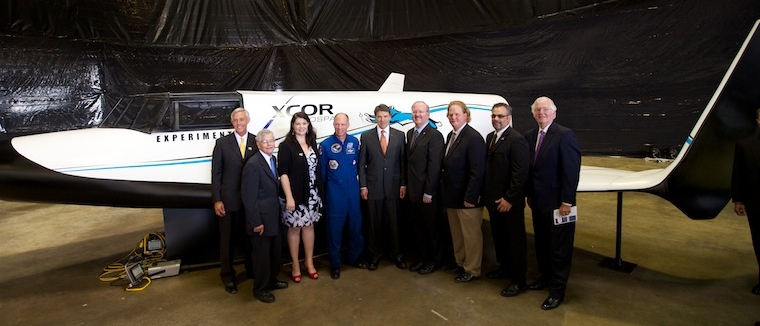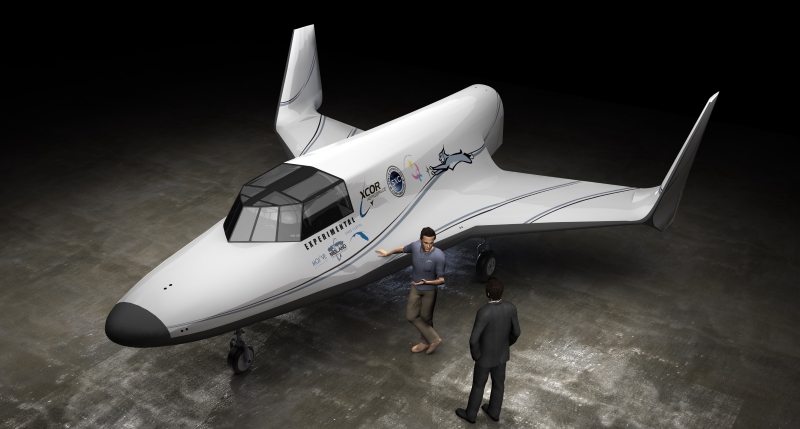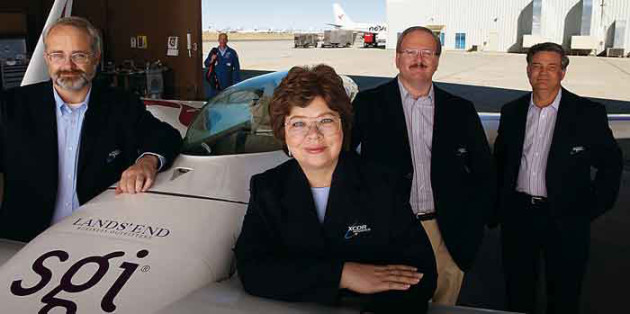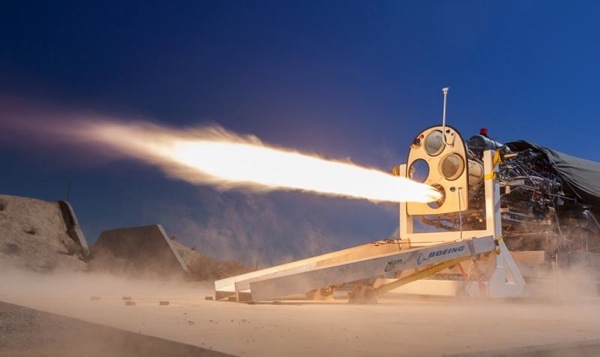XCOR Aerospace filed for bankruptcy
One private company and operator of suborbital tourism became less - on November 8, XCOR Aerospace, having worked in the space industry for almost 20 years, filed for bankruptcy under Chapter 7, which implies the liquidation of the company.

XCOR AEROSPACE staff and Texas Governor Rick Perry, source
Alas, it cannot be said that this was a tragic surprise, the news about the company's problems has been going on for quite some time. In 2015, the CEO was replaced, and three of the founders left, creating a new aerospace company Agile Aero. In 2016, the state was cut in about half, mainly by sacking people involved in the Lynx suborbital space plane, in order to focus on building the hydrogen engine for the ACES top stage being developed under a contract with the United Launch Alliance. In 2017, having worked for just two years, the new CEO, Donald Trump, invited me to the Department of Defense, and a week later, all the remaining staff was cut. The last of the remaining founders in the summer of 2017 went to Deep Space Industries. For several months, the company hung in the balance in the hope of finding new investors, but this did not happen. Court documents say that XCOR has assets of $ 1-10 million, debts from 10 to 50 million and from 100 to 199 creditors.
The company XCOR Aerospace was founded in 1999 by engineers who left the bankrupt private space company Rotary Rocket. Almost immediately, noticeable results appeared - in 2000, they began testing their own rocket engine, and in 2001, the first private rocket plane, EZ-Rocket, flew.
')

EZ-Rocket in flight, photos of Corkeyandpals / http: //aircraft.wikia.com
The device set several records - the first go-around with a touch of the runway for a rocket plane, a 16 km flight, the first officially delivered mail to a manned rocket plane.
Since 2003, the development of a suborbital spaceplane for space tourism began. An aircraft with a rocket engine was supposed to start from the runway, climb to a height of 100 km and then plan back. Ideally, the unit could make several flights in one day. Until 2007, the project was called Xerus, then renamed it Lynx.

Lynx, image XCOR Aerospace
For use as a technology demonstrator, a rocket engine was installed instead of a piston plane on a Velocity SE aircraft, the resulting apparatus called Rocket Racer was shown at an air show and even wanted to organize a race of rocket aircraft, for which they created the League of Rocket Races In 2008, Rocket Racer flew beautifully at an air show in Oshkosh.
XCOR managed to collaborate with NASA, developing a rocket engine for the take-off stage of the lunar module under the program Constellation (stopped in 2009). In 2011, the company announced the start of a joint development with the ULA of an oxygen-hydrogen engine of 11-13 tons, the first test was carried out in 2013, and it was successful. In 2015, it was announced that engines from XCOR Aerospace, Blue Origin BE-3 or the existing RL-10 for a long time could be installed on the ACES perspective stage being developed.

Founders of XCOR Aerospace, from left to right Doug Johns, Aleta Jackson (died 2016), Jeff Grison, Den Delong, Lands' End photo
Over the past few days have already appeared materials telling about the reasons for the collapse of the company. Henry Vanderbilt, a former employee and shareholder of XCOR Aerospace, writes that the reason was management. Allegedly, the fact is that the company's founding engineers could not cope with their management tasks. According to Henry, the collapse of XCOR Aerospace was “a long, painful and highly entangled founder founder syndrome” - a situation where startup founders, techies, cannot cope with the growth of their management tasks while the company grows.
Regardless of whether Henry is right or not, this sad story is another reminder of the difficulty of trying to make money in space. Even if the company produces new, unique and remarkably working samples of technology, it does not always manage to live to the moment when they begin to make a profit. In general, according to the experience of other companies, there is a feeling that permanent sources of income in other or related areas are extremely useful for a private space company. Investment news, which XCOR Aerospace recently published, and information that it was valued at $ 140 million, alas, was not enough. Bezos may sell Amazon shares for $ 1.1 billion to support his Blue Origin space project, but Rocket Lab, which has refused military contracts, does not have an airbag that could help her in a period of difficulties.

Piston rocket pump, drawing XCOR Aerospace
The main idea of the XCOR Aerospace engines was the use of piston pumps instead of turbines. A small loss in efficiency was more than compensated for by the simplicity of the design, as a result of which engines were designed and built quickly, and for its not very long life, the company managed to test several models. Listen to how you start the engine, the crackling before turning on, for sure, the operation of the pump.
The XR-8H21 is an oxy-hydrogen engine with excellent performance — an 11 ton barge and a specific impulse for 460 seconds. High engine performance means that ULA or Orbital ATK (recently purchased by Northrop Grumman) can buy it. Even SpaceX could be useful for such an engine - they do not have their own oxygen-hydrogen, and the oxygen-kerosene engine has less specific impulse, which is unpleasant on the upper steps.

Engine XR-5K18, photo XCOR Aerospace
The XR-5K18 is an oxygen-kerosene engine suitable for multiple start-ups that can potentially be useful to many rocket startups - it is simple, can be used many times and has been tested since 2008, which promises its high reliability.

Lynx nose assembly, photo XCOR Aerospace
The Lynx space plan is about 2/3 ready, the entire flight profile has been extensively investigated in the wind tunnel, and the device has no theoretical obstacles to flight. He may be interested in both space startups dreaming of suborbital space tourism and large companies like Boeing or Lockheed Martin, which will be able to base it, for example, to create an ultra-light air launch vehicle with a reusable first stage.
No matter how sad the bankruptcy of XCOR Aerospace, the results of their work may well be bought and used by someone else. If knowledge, an unusual approach to the creation of a rocket engine and potentially promising developments remain, for the progress of humanity XCOR Aerospace will remain alive.

XCOR AEROSPACE staff and Texas Governor Rick Perry, source
Rise and fall
Alas, it cannot be said that this was a tragic surprise, the news about the company's problems has been going on for quite some time. In 2015, the CEO was replaced, and three of the founders left, creating a new aerospace company Agile Aero. In 2016, the state was cut in about half, mainly by sacking people involved in the Lynx suborbital space plane, in order to focus on building the hydrogen engine for the ACES top stage being developed under a contract with the United Launch Alliance. In 2017, having worked for just two years, the new CEO, Donald Trump, invited me to the Department of Defense, and a week later, all the remaining staff was cut. The last of the remaining founders in the summer of 2017 went to Deep Space Industries. For several months, the company hung in the balance in the hope of finding new investors, but this did not happen. Court documents say that XCOR has assets of $ 1-10 million, debts from 10 to 50 million and from 100 to 199 creditors.
The company XCOR Aerospace was founded in 1999 by engineers who left the bankrupt private space company Rotary Rocket. Almost immediately, noticeable results appeared - in 2000, they began testing their own rocket engine, and in 2001, the first private rocket plane, EZ-Rocket, flew.
')

EZ-Rocket in flight, photos of Corkeyandpals / http: //aircraft.wikia.com
The device set several records - the first go-around with a touch of the runway for a rocket plane, a 16 km flight, the first officially delivered mail to a manned rocket plane.
Since 2003, the development of a suborbital spaceplane for space tourism began. An aircraft with a rocket engine was supposed to start from the runway, climb to a height of 100 km and then plan back. Ideally, the unit could make several flights in one day. Until 2007, the project was called Xerus, then renamed it Lynx.

Lynx, image XCOR Aerospace
For use as a technology demonstrator, a rocket engine was installed instead of a piston plane on a Velocity SE aircraft, the resulting apparatus called Rocket Racer was shown at an air show and even wanted to organize a race of rocket aircraft, for which they created the League of Rocket Races In 2008, Rocket Racer flew beautifully at an air show in Oshkosh.
XCOR managed to collaborate with NASA, developing a rocket engine for the take-off stage of the lunar module under the program Constellation (stopped in 2009). In 2011, the company announced the start of a joint development with the ULA of an oxygen-hydrogen engine of 11-13 tons, the first test was carried out in 2013, and it was successful. In 2015, it was announced that engines from XCOR Aerospace, Blue Origin BE-3 or the existing RL-10 for a long time could be installed on the ACES perspective stage being developed.
Why?

Founders of XCOR Aerospace, from left to right Doug Johns, Aleta Jackson (died 2016), Jeff Grison, Den Delong, Lands' End photo
Over the past few days have already appeared materials telling about the reasons for the collapse of the company. Henry Vanderbilt, a former employee and shareholder of XCOR Aerospace, writes that the reason was management. Allegedly, the fact is that the company's founding engineers could not cope with their management tasks. According to Henry, the collapse of XCOR Aerospace was “a long, painful and highly entangled founder founder syndrome” - a situation where startup founders, techies, cannot cope with the growth of their management tasks while the company grows.
Regardless of whether Henry is right or not, this sad story is another reminder of the difficulty of trying to make money in space. Even if the company produces new, unique and remarkably working samples of technology, it does not always manage to live to the moment when they begin to make a profit. In general, according to the experience of other companies, there is a feeling that permanent sources of income in other or related areas are extremely useful for a private space company. Investment news, which XCOR Aerospace recently published, and information that it was valued at $ 140 million, alas, was not enough. Bezos may sell Amazon shares for $ 1.1 billion to support his Blue Origin space project, but Rocket Lab, which has refused military contracts, does not have an airbag that could help her in a period of difficulties.
Heritage

Piston rocket pump, drawing XCOR Aerospace
The main idea of the XCOR Aerospace engines was the use of piston pumps instead of turbines. A small loss in efficiency was more than compensated for by the simplicity of the design, as a result of which engines were designed and built quickly, and for its not very long life, the company managed to test several models. Listen to how you start the engine, the crackling before turning on, for sure, the operation of the pump.
The XR-8H21 is an oxy-hydrogen engine with excellent performance — an 11 ton barge and a specific impulse for 460 seconds. High engine performance means that ULA or Orbital ATK (recently purchased by Northrop Grumman) can buy it. Even SpaceX could be useful for such an engine - they do not have their own oxygen-hydrogen, and the oxygen-kerosene engine has less specific impulse, which is unpleasant on the upper steps.

Engine XR-5K18, photo XCOR Aerospace
The XR-5K18 is an oxygen-kerosene engine suitable for multiple start-ups that can potentially be useful to many rocket startups - it is simple, can be used many times and has been tested since 2008, which promises its high reliability.

Lynx nose assembly, photo XCOR Aerospace
The Lynx space plan is about 2/3 ready, the entire flight profile has been extensively investigated in the wind tunnel, and the device has no theoretical obstacles to flight. He may be interested in both space startups dreaming of suborbital space tourism and large companies like Boeing or Lockheed Martin, which will be able to base it, for example, to create an ultra-light air launch vehicle with a reusable first stage.
Conclusion
No matter how sad the bankruptcy of XCOR Aerospace, the results of their work may well be bought and used by someone else. If knowledge, an unusual approach to the creation of a rocket engine and potentially promising developments remain, for the progress of humanity XCOR Aerospace will remain alive.
Source: https://habr.com/ru/post/373987/
All Articles